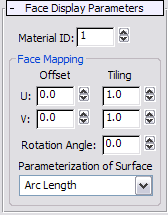Use these settings to define material and mapping properties such as ID, offset, and tiling for selected faces.
To use, access the Face sub-object level, select one or more faces in the Body Object, and then adjust the settings. To best see the results, apply a textured material first and set the texture map to display in the viewports.
Tip: To best see the texturing changes as you adjust these settings, turn off the Shade Selected Faces toggle in the Viewport Configuration dialog  Rendering Options group (keyboard shortcut=F2).
Rendering Options group (keyboard shortcut=F2).
 Rendering Options group (keyboard shortcut=F2).
Rendering Options group (keyboard shortcut=F2). These settings are available only when one or more faces are selected.

- Material ID
- The material ID of selected faces, used by multi-materials such as Multi/Sub-Object. Tip: If you plan to combine 3ds Max primitives into a Join Bodies or Body Cutter object and then change Material IDs of some faces for subsequent application of a multi-material, for best results first convert each of the primitives to a Body Object individually and change the face Material IDs of the Body Objects.
Face Mapping group
Face material mapping is applied in the UV space of the face.
- U/V Offset
- Material offset in U or V direction.
- U/V Tiling
- Number of divisions in U or V direction for tiling the material as it is applied to the faces.
- Rotation Angle
- The amount by which the applied material is rotated.
- Parameterization of Surface
- Specifies how the surface is parameterized, which determines how the tiling will work for applied textures. The options are:
- Arc Length Measures the length of the sides of the surface and adjusts the parameterization to match the length. This is a good setting to get a more or less even tiling across the entire model.
- Natural The tiling will match what ever the default surface parameterization of the underlying NURBS surface for each face.
- Normalized All surfaces will be reparameterized to the range of 0 to 1 in both directions. This method is recommended when you want to control the tiling explicitly and have it start and end at the tile boundaries.